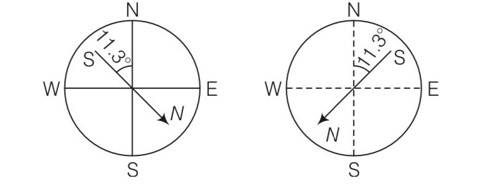The magnetic field of the earth’ can be modelled by that of a point dipole placed at the centre of the earth. The dipole axis makes an angle of 11.3° with the axis of the earth. At Mumbai, the declination is nearly zero. Then
(a) The declination varies between 11,3°W to 11.3°E
(b) The least declination is 0°
(c) The plane defined by dipole axis and the earth axis passes through Greenwich
(d) Declination averaged over the earth must be always negative
The magnetic field of the earth’ can be modelled by that of a point dipole placed at the centre of the earth. The dipole axis makes an angle of 11.3° with the axis of the earth. At Mumbai, the declination is nearly zero. Then
(a) The declination varies between 11,3°W to 11.3°E
(b) The least declination is 0°
(c) The plane defined by dipole axis and the earth axis passes through Greenwich
(d) Declination averaged over the earth must be always negative
-
1 Answer
-
This is a Multiple Choice Questions as classified in NCERT Exemplar
Answer- (a)
Explanation- for the earth's magnetism, the magnetic field lines of the earth resemble that of a hypothetical magnetic dipole located at the centre of earth.
The axis of the dipole not coincide with the axis of rotation of the earth but is presently tilted 11.30 with respect to the later or it is either towards east or towards west

Similar Questions for you
There are various important topics in the physics chapter 5 class 12 magnetism and matter. These topics are important for both cases, conceptual and numerical questions. Read below:
- Magnetism
- Bar Magnet as an Electromagnet
- Magnetic Field Due to Magnetic Dipoles
- Type of Magnetic Materials: Ferromagnetic, Paramagnetic, and Diamagnetic
- Magnetisation and Magnetic intensity
- Magnetic Susceptibility
- Magnetic Flux Intensity
- Potential energy due to a magnetic dipole
In JEE Main exam, it is a significant chapter. There can be 6 to 8 questions from this chapter, a weightage of nearly 6.6%.
The exact weightage varies from year to year. This chapter comes under a broader category which can be "Magnetism" or "Modern Physics". In NEET exam, the chapter's weightage is low to moderate and there can be 6-7% of questions from this chapter.
The chapter is one of the small and easy chapter of class 12 Physics. It includes - properties of magnetic materials, magnetic dipoles, and Earth's magnetic field.
When the electric charges moves, it creates attraction or repulsion. It creates magnetic forces and fields and called magnetism. The term "magnetism and matter" talks about the way magnetic forces and matter interact.
Taking an Exam? Selecting a College?
Get authentic answers from experts, students and alumni that you won't find anywhere else
Sign Up on ShikshaOn Shiksha, get access to
- 65k Colleges
- 1.2k Exams
- 679k Reviews
- 1800k Answers
